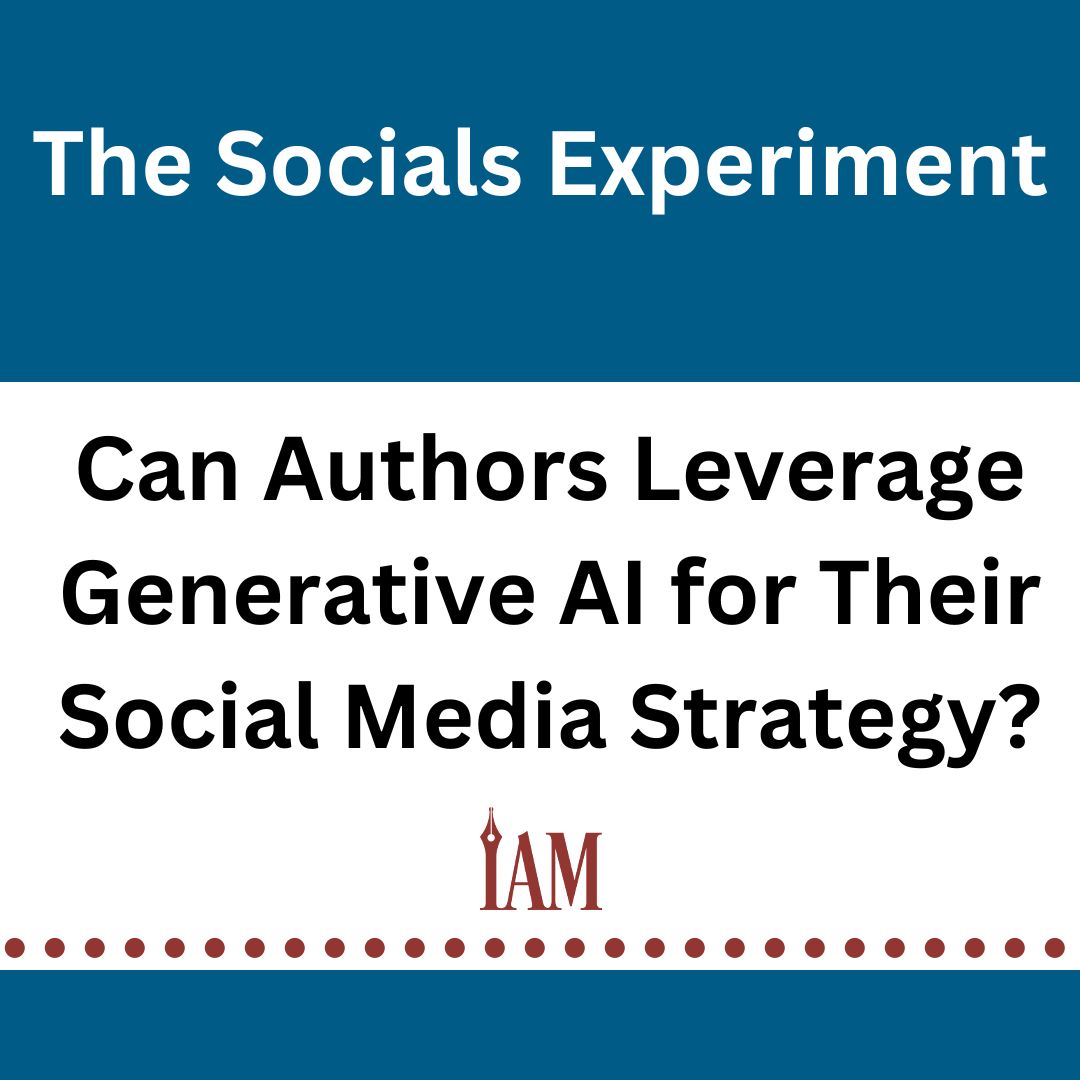Can Authors Leverage Generative AI for Their Social Media Strategy?
Social media, in all its guises, is a fabulous way for authors to showcase their wares. We can promote our work and potentially attract a dedicated audience who will derive ongoing value from our writing and hopefully provide an income through future sales.
However, for some of us, it also feels like A MASSIVE TIME SUCK SENT FROM HELL TO DEMORALIZE US UNTIL THERE IS NOTHING LEFT. (Was I shouting? Apologies.) In more composed terms, it can feel like a burden. With an abundance of social media platforms available, many authors find themselves trapped in anonymity and often spend excessive amounts of time focused on marketing rather than their writing.
Authors have long searched for a way to create and post engaging content and write all the words—and with the help of modern AI-powered tools, there may finally be an answer. Some would say we’re about to dance with the devil himself. Strap in; we are going to the dark side, or the blessed relief, that is generative AI for social media.
Generative AI is a type of artificial intelligence that can take human inputs and create something new, like art, writing, video, or audio. Given a prompt, it generates its own creation with predictions based on its training data. Because it makes conveying ideas easier and faster, generative AI has the potential to be a transformative technology for productivity and creativity.
There is a division within the author community that questions the legitimacy of AI-generated content, particularly within the context of its training data. However, the concerns may be lessened when the AI is fed source material created largely by the author using it, or when exploring AI’s other uses as an efficiency tool, particularly in terms of social media.
Hubspot’s State of AI survey discovered that social media posts are the top content type for generative AI in 2023. Other findings include:
- 67 percent of marketers say the biggest benefit of AI is the ability to create content faster.
- 35 percent of surveyed marketers report using AI to get ideas or inspiration.
- 13 percent of marketers report using AI for repurposing content, enabling them to get more traction content-wise.
- 48 percent of marketers say the biggest benefit of AI is the ability to generate new ideas.
What does this mean in author speak?
Imagine feeding your synopsis into a generative AI platform and it delivering your blurb, tagline, and social media content in response. It’s a nice thought, but are these creations truly worth using? In the name of journalism, this author has done exactly that to find out.
The Experiment
As a time-poor, often technologically challenged author with a mediocre social media game, I wanted to know if AI would deliver an engaging suite of content that was both user- and engagement-friendly.
I used ChatGPT for the experiment, beginning with asking the bot to tell me about one of my own books with only the title and author as prompts. ChatGPT produced a couple of paragraphs about my book—that were completely off-target and off-genre. After a one-sided conversation in which I questioned the intelligence of this artificial being, it occurred to me that the problem was … me. I had not been targeting the market I wanted to target. Apologies were made.
The next step was gathering all the reviews for said book, feeding them into ChatGPT and asking the program for common themes. Et voila, ideas for social media content, and for rewording my blurb.
I then fed the program my new blurb and a bunch of pithy, one- and sometimes two-line phrases that had resonated with readers, such as “gripping page-turner” and “emotional rollercoaster.” Plot points and character arcs mentioned in reviews also helped determine promotional and content opportunities. Because I performed these two activities back to back, the program used all the data to collate its response.
AI mimics humans, but it isn’t human. I needed to edit ChatGPT’s content until it fit my voice and targets. But was it better than staring at a blank page and muttering profanities? In a word, yes. Instead of the hours or days of manual research, and trying to use my brain after said manual research, the process took about an hour. I should add that I didn’t have hundreds of reviews to feed into the program. Even so, copying and pasting is so much faster than manually collating themes and ideas.
Generative AI offers benefits beyond content creation, such as scheduling and posting content, analyzing audience analytics, and creating unique visuals. It can also help with a more strategic focus, such as analyzing research by taking pages of your own and competitors’ reviews and summarizing the information into key takeaways and an overarching statement. Taking a sample of a genre-relative bestselling author’s reviews and getting ChatGPT to tell you what readers most like about their work can give invaluable insight into what has made that author a bestseller.
When it comes to creating social media content, break through writer’s block by asking for a transition line from the last statement you wrote. Another option is translating text and adjusting it to sound more natural in a targeted language. While it’s not a complete replacement for localization and cultural adaptation across global communities, generative AI can certainly accelerate that process.
The Caveats
Generative AI does not provide you with backlinking and sourcing in the content it produces, and some have expressed concern that, by ignoring the original content’s creators, there is a risk of plagiarism. However, if the program you use creates content derived from your own material, that problem may be resolved.
As previously mentioned, human editors are still needed to review AI-generated content before publication, even on social media. It also doesn’t hurt to get a second set of eyes on the content if you’re unsure. As for content bias, if the outcome is not hitting the mark and the source material is your own, perhaps your original attempts at content were off target (refer to this writer’s experiment).
Rapid technological advancements mean that regulatory frameworks and ethical guidelines still have to catch up. It’s a case of watching this space when it comes to legal and ethical implications. For now, it seems the biggest issue standing in the way of generative AI for social media is possibly our own concerns about authenticity. But as Mark Twain once said, there is no such thing as an original thought. And with the firm consensus that you need to put your personal brand on anything you intend to post, authenticity is built into the process.
The Tools
So if AI interests you, what tools should you be using? Ask that question out loud next to your smartphone and your Facebook feed will likely provide you with a plethora of options. Alternatively, check out this list of some of the more popular generative AI platforms.
Publer helps create, bulk schedule, and analyze social media posts.
Jasper.ai, ChatGPT, and Peppertype.ai help you brainstorm and generate AI-powered content.
Murf AI is an AI voice generator for creating audio content for your posts.
Frase helps research, write, and optimize content.
Ocoya allows you to create content, images, and music from a single platform.
GrowthBar not only helps you create compelling content for social media; it also helps you to understand your competitors’ strategies. You can review their keywords, Google Ads, and backlinks to get a better understanding of how to outrank them.
Munch extracts the most engaging contextual nuggets from your long-form content and presents you with coherent, shareable clips.
Writesonic creates any type of creative copy. This tool can help you create SEO-optimized content for your blogs, ads, emails, and website.
Copy.ai can help you write long-form content and social media messages optimized for different platforms. If you’re creating social copy, Copy.ai will generate multiple options for you to use.
Midjourney uses AI to identify keywords and phrases and generates an image that reflects those keywords. This approach makes it much easier to create visuals that capture the essence of your message.
Many of these programs offer free trials, and it’s a good idea to ensure you have the time to invest in experimenting during the free phase in order to generate enough data and decide whether to invest in the tool down the road.
Generative AI’s potential uses in content development, ideation, and content adaptation for social media make it a uniquely powerful tool for any author. Depending on how you choose to use it, it can be a remarkable time-saving solution and a worthwhile investment for many. With the power of AI, a well-crafted prompt is all it takes to develop a more targeted social media strategy and save you time that can be redirected back to writing.






